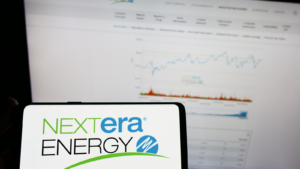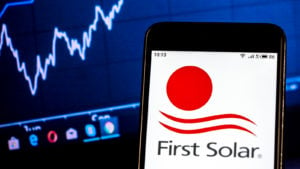
As much as there is a belief in the future of fossil fuels as a superior energy source to meet global demand, there are clearly profitable opportunities in renewable energy stocks to buy.
The U.S. Energy Information Administration forecasts electricity generation will grow by about 3% in 2024 and 1% next year with renewables — mostly solar — supplying most of that growth.
Solar will provide 41% more electricity in 2024 than last year while wind will grow 5% this year. Hydropower generation is expected to see a 6% increase in 2024. Next year, the EIA expects solar will generate more electricity than hydropower for the first time in history.
Below are three of the leading renewable energy stocks to buy that tap into each of those sectors. By spreading investments across the full range of clean energy opportunities, investors can benefit from the advantages each brings to the market.
NextEra Energy (NEE)

Utility operator NextEra Energy (NYSE:NEE) is the first renewable energy stock that investors should consider buying. It is the world’s largest generator of renewable energy from the wind and sun and a top-tier stock in battery storage. At the end of 2023, NextEra had approximately 72 gigawatts (GW) of total capacity in its portfolio. Of that amount, half or 36 GW came from renewables, some 70% more than its nearest competitor with wind power represented as two-thirds of the total renewable capacity.
Over the past decade, NextEra nearly tripled its wind energy capacity and has the largest market share of North American wind capacity, all the while it keeps adding to the total. The utility has more than 20 GW backlog of wind, solar and storage contracts.
Analysts at McKinsey forecast between 2024 and 2030, demand for renewables and storage will expand at a 13% compounded annual growth rate (CAGR). NextEra Energy will be one of the top renewable energy stocks to buy that leads the way.
Brookfield Renewable Partners (BEP)

Where NextEra dominates the wind market, Brookfield Renewable Partners (NYSE:BEP) is the leading provider of hydropower in the country. It operates as one of the world’s largest publicly traded platforms for renewable power and decarbonization solutions.
Yet where 85% of Brookfield’s portfolio was once hydropower generation, today it stands at about 50% as the company grew through mergers and acquisitions. It took on more solar and wind assets, such as its recently announced acquisition of Neoen, a French developer and operator of solar power plants, wind farms and energy storage solutions. The purchase gives Brookfield access to Neoen’s 20 GW development pipeline.
In expanding its portfolio to encompass more forms of renewable energy, Brookfield Renewable has also widened the lens on where it operates. Although it primarily has projects in North America and Latin America, more recently as the Neoen acquisition shows, it is expanding more towards Europe and Asia.
BEP is a renewable energy stock to buy because of its hydro sector dominance that cannot be easily, or readily, replicated. Building out new hydro projects faces a daunting, uphill regulatory climb. As the industry leader, Brookfield Renewable Partners is one of the best investments in the space.
First Solar (FSLR)

The last renewable energy stock to buy completes the triumvirate of sources in solar. First Solar (NASDAQ:FSLR) is the world’s leading manufacturer of thin-film solar panel technology and a pure-play in the solar panel space. It focuses on the U.S. and Indian markets where the greatest booking potential lays, particularly in the domestic utility-scale market.
Despite the ups and downs of the solar industry over the years, First Solar has built a solid financial foundation and a strong balance sheet to weather future storms. It’s thin-film cadmium telluride technology is distinctive in the industry that benefits from its simple manufacturing process.
First Solar should also benefit from the Biden administration’s protectionist trade policies. It recently imposed high-import barriers on cheaper Chinese panels that should give the solar shop greater opportunities, even though it comes at a higher cost to customers.
The solar industry is currently facing a tough market due to high interest rates slowing demand, but with its utility-scale focus, it can overcome such obstacles. The promise of interest rate cuts could spur a new growth phase.
On the date of publication, Rich Duprey did not hold (either directly or indirectly) any positions in the securities mentioned in this article. The opinions expressed in this article are those of the writer, subject to the InvestorPlace.com Publishing Guidelines.






